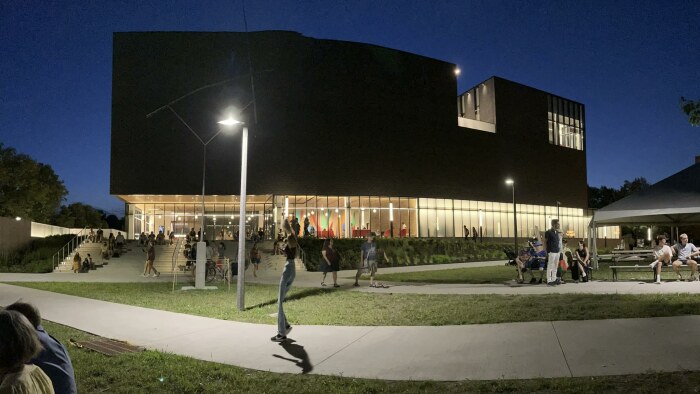This column by Daniel G. Clark about Alexander Clark (1826-1891) first appeared in the Muscatine Journal.
Across a crowded lobby, I recognize Iowa’s one-time state architectural historian who married a candidate for Congress. It’s one of the opening events at the spectacular new Stanley Museum of Art. She is serving as a greeter.
Calling card in hand, I make my way to her side. Scribbled on the back: “Alexander Clark House.”
She glances at the words. “That is one of my favorite places,” she says.
A young professional designer returned to his hometown to save a historic house. He’s still at it, 40-plus years later.
I am a board member of the foundation Kent Sissel created for long-term preservation of the house and the legacy of the “equal rights pioneer” who built it.
I asked Kent, now 78, to tell again how he got involved in what became his life work. I knew he did it instead of completing PhD work at Penn State.
“All but dissertation,” he said. “I left my education.”
Muscatine Journal, March 9, 1979:
Representatives of the Alexander G. Clark Historical Society announced Thursday that the former home of Clark…has been tentatively sold to Kent Sissel of Muscatine, a historic preservationist who has several other restoration projects to his credit.
The group that moved the 1878 house to make way for a high-rise apartment building had missed several deadlines for correcting code violations at the new location. The city council was poised to order demolition when young Sissel appeared.
Pat Eckhardt of the Iowa Division of Historic Preservation addressed the council and “said her agency considers the house as ‘the last physical remembrance of Alexander Clark, whom she described as ‘a man of national significance.’”
“Deba Foxley asked me to take on the troubled project,” Kent said.
I found a Journal article (August 10, 1974) reporting that a team of preservationists would conduct a two-week survey of Iowa cities along the Mississippi River. Two of those days would focus on Muscatine. Traveling with representatives of the National Trust for Historic Preservation and the National Register of Historic Places would be Adrian Anderson, the archaeologist who was Iowa’s first Historic Preservation Officer, and “Miss Elizabeth Foxley, architectural historian of the Iowa State Historic Preservation Program.”
“Miss Foxley and Kent Sissel of Muscatine will present a program to the Kiwanis Club….”
From a letter in the Journal, May 14, 1976:
Muscatine has much to celebrate and conserve. From the handsome courthouse and precious (one of a kind) county jail, to the Victorian residences and rural structures, Muscatine county has a unique character.
Signed: Elisabeth Foxley Leach (Mrs. James A.S. Leach)
Deba Foxley Leach left her post and listened to my story, of Kent and our quest for national recognition, of my Black History Month column that turned into this weekly project. I said I wanted her to verify Kent’s claim that she got him into all this.
“I can claim I did that,” she said. Then she added: “Thanks for keeping the flame alive.”
I went back to Kent for more. How did he get chosen?
“Oh, they were consultants on my masters thesis,” he said. “Adrian and Deba and Lowell Soike; Lowell was the state historian.”
So Deba tapped him, and all three talked him into it. (More of this some other time.)
In a column several months ago, I told of our National Historic Landmark goal and the problem of establishing “national significance” versus state-level which is how the feds view Alexander Clark. To that end, we’ve engaged Rebecca Lawin McCarley who’s led projects that gained National Register recognition for several Muscatine area properties and districts.
When I said I’d like to write about her, she replied: “In terms of publicizing the steps for the Clark House, I would just caution you on not overstating what step we are [at] currently – i.e. to complete research and determine a national case for significance per National Register standards.” Building that case, she said, “would be a precursor to a potential National Historic Landmark listing.
Kent told a Journal reporter (February 19, 2012):
I’m retired—and tired. I’ve probably got 100 projects I could pursue. Every day I try to push one of those projects a little further. …
I am still pursuing the idea that the property be institutionalized and used for educational purposes and no longer as a residence. I think we’re headed in that direction.
Kent’s thesis, back in 1968? “The Octagon Form in Nineteenth Century Domestic Architecture of Iowa.” The topic originated in Muscatine, where he was fascinated by the Sinnett Octagon House.
Connecting more dots: From the 1974 report of the preservation officials’ foray: “Mrs. C.M. Stanley of Muscatine is a former member of the board of the National Trust.”
The next time you’re in Iowa City, do make time for visiting “The Stanley.” My newest favorite place.
Next time: She presented herself as a scholar
Top image: The Stanley Museum of Art. Photo provided by Daniel G. Clark and published with permission..

